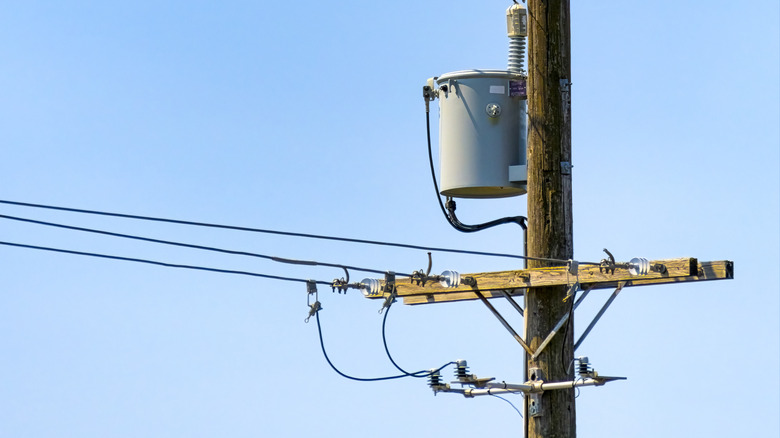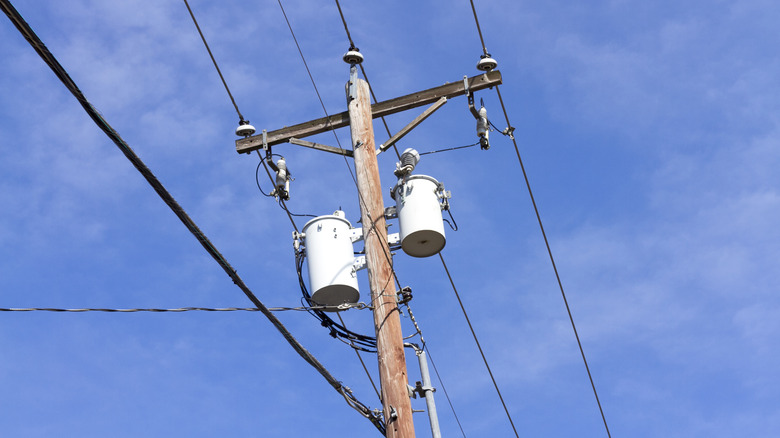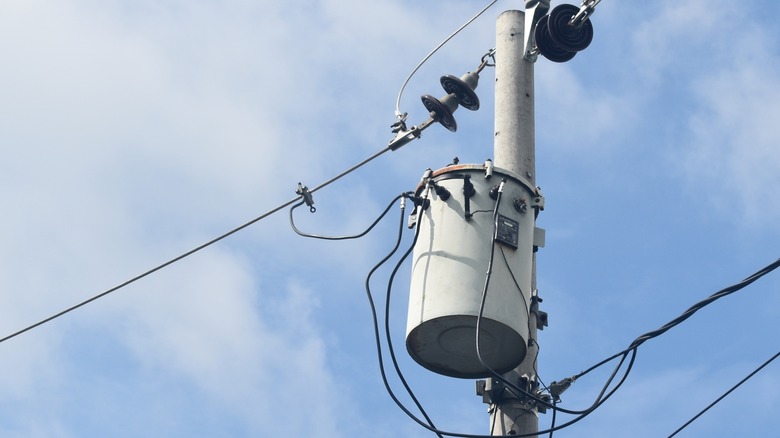What Are Those Cylinders On Power Lines For?
Once electricity finally reaches your home from the power plant, it's not in the same form that it left in. When power is created at a plant, it's produced at a voltage that's either too low or too high for long-distance travel (let alone home use). To send that energy across long distances, the voltage has to be adjusted. This is where those cylinders on the power lines come in: By boosting the voltage — think of it like "electrical pressure" — the electricity can travel hundreds of miles with very little loss.
But once that high-voltage electricity reaches your neighborhood, it's still way too powerful for your household appliances. (Hooking up your gaming console or your fridge directly to one of these high-voltage lines would instantly fry it.) That's why the voltage needs to go through another major change before it enters your home. That's the job of pole-mount transformers (also known as distribution transformers): These cylinders, held up there by the metal springs, reduce the voltage to a usable level for residential buildings, somewhere around 120/240 volts.
How do pole-mount transformers work?
Pole-mount transformers work based on a principle called electromagnetic induction. Inside each transformer are two coils of wire, the primary and the secondary. These are wrapped around an iron core. When alternating current (AC) electricity flows into the primary coil, it creates a magnetic field. This magnetic field induces a current into the secondary coil. The number of wire loops (also known as turns) in each coil determines how much or how little the voltage is adjusted. It's simple math and science from this point: If the primary coil has 25 times more loops than the secondary, the transformer will reduce the voltage by a factor of 25.
These transformers are also referred to as distribution transformers because they are distributing the electricity from the power plant to the residential home. (You might also see them in box form on the ground. Ever spotted one of those big, green boxes peppered throughout a neighborhood? That's a transformer.) The cylindrical versions you see on power poles are designed for more remote or rural areas where transformers on the ground would be too impractical or too costly. Instead of a large ground-based unit, utility companies can quickly attach a transformer to an existing pole and run lines directly to a home or small facility.
What causes a pole-mount transformer to fail?
While their main purpose is to lower the voltage for safe use in residential and commercial buildings, pole-mount transformers can also work in reverse: by increasing voltage for industrial settings. Either way, under ideal conditions, a pole-mount transformer can last up to 30 or 40 years.
Regular inspection and maintenance is important to make sure that the transformer stays sealed, functional, and free from corrosion. Even so, they're pretty low maintenance overall. Most are filled with a special cooling fluid that helps manage heat from the electrical currents. Without this cooling fluid, the transformer could overheat and even explode.
Beyond poor maintenance, environmental factors like extreme weather or damage from falling branches can also shorten that lifespan. Once the cooling fluid is compromised or its components begin to corrode, the transformer has to be repaired or replaced as soon as possible for everyone's safety (not to mention for maximum power grid efficiency).
As for how many homes one transformer can support, it varies based on demand and unit size. In rural or remote areas where houses are more spread out, each building may have its own transformer. In more densely populated neighborhoods, you might see multiple homes connected to a single transformer. Typically, a small residential pole-mount transformer can serve as many as five to seven homes max.


